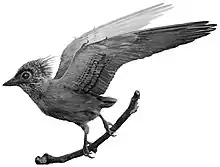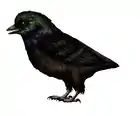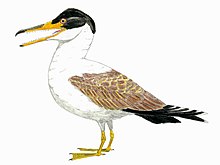| Yaverlandia Temporal range: Early Cretaceous, | |
|---|---|
 | |
| Replica of MIWG 1530 seen from two different angles | |
| Scientific classification | |
| Domain: | Eukaryota |
| Kingdom: | Animalia |
| Phylum: | Chordata |
| Clade: | Dinosauria |
| Clade: | Saurischia |
| Clade: | Theropoda |
| Clade: | Maniraptoriformes |
| Clade: | Maniraptora |
| Genus: | †Yaverlandia Galton, 1971 |
| Species: | †Y. bitholus |
| Binomial name | |
| †Yaverlandia bitholus Galton, 1971 | |
Yaverlandia (meaning "of Yaverland Point/Yaverland Battery") is a genus of maniraptoran dinosaur. Known from a partial fossil skull (MIWG 1530) found in Lower Cretaceous strata of the Wessex Formation (Upper Silty Bed; Vectis Formation) on the Isle of Wight.[1][2][3] it was described as the earliest known member of the pachycephalosaurid family, but research by Darren Naish shows it to have actually been a theropod, seemingly a maniraptoran.[4] The type species is Y. bitholus.[5]
Discovery and naming
MIWG 1530, the holotype skull, was discovered in 1930, in England and were commented upon by Watson (1930).[6][7] It was referred to as an iguanodontid of the genus Vectisaurus in 1936.[8] When Steel (1969) followed Hulke (1879)[9] in listing Vectisaurus as an iguanodontid, Peter Malcolm Galton (1971) named the fossil as Yaverlandia, which he described as a pachycephalosaurid since the skull of Yaverlandia was different than that of Vectisaurus (Mantellisaurus).[5]
In 2012 additional remains were reported, but these have not been described.[10]
Description
Yaverlandia was about 3 ft (1 m) in length and 1 ft (30 cm) in height.[11]
Classification
Before being named, Swinton (1936) had MIWG 1530 placed within Mantellisaurus,[8] which was a member of the Iguanodontidae. Galton (1971) upon describing Yaverlandia placed it within the Pachycephalosauridae.[5] Sullivan (2000), Sereno (2000)[12] Naish (2006; unpublished thesis), Sullivan (2006)[13] and Naish (2008)[4] all re-classified Yaverlandia as a maniraptoran.
Paleoecology
Yaverlandia was found in the Vectis Formation and it would have coexisted with the nodosaur Polacanthus,[14] the neornithischian Hypsilophodon,[14] the iguanodontid Mantellisaurus,[14] an indeterminate euornithopod,[14] the spinosaur Baryonyx,[15] the Vectiraptor,[14] the plesiosaur Vectocleidus pastorum[16] and the crocodylomorph Hylaeochampsa vectiana.[17]
References
- ↑ Weishampel, David B; et al. (2004). "Dinosaur distribution (Early Cretaceous, Europe)". In: Weishampel, David B.; Dodson, Peter; and Osmólska, Halszka (eds.): The Dinosauria, 2nd, Berkeley: University of California Press. Pp. 556-563. ISBN 0-520-24209-2.
- ↑ Batten, D. J. (ed.) 2011. English Wealden Fossils. The Palaeontological Association, London.
- ↑ "Magnetostratigraphy of the Lower Cretaceous Vectis Formation (Wealden Group) on the Isle of Wight, Southern England."
- 1 2 Naish, Darren; Martill, David M. (2008). "Dinosaurs of Great Britain and the role of the Geological Society of London in their discovery: Ornithischia". Journal of the Geological Society, London. 165 (3): 613–623. doi:10.1144/0016-76492007-154. S2CID 129624992.
- 1 2 3 Galton, P.M. (1971) "A primitive dome-headed dinosaur (Ornithischia: Pachycephalosauridae) from the Lower Cretaceous of England and the function of the dome of pachycephalosaurids". Journal of Paleontology, Vol. 45, No. 1, Pages 40–47.
- ↑ Watson, D.M.S (1930) Proceedings of the Isle of Wight Natural History Society. 2, 60.
- ↑ BBC: Dinosaurs of The Isle of Wight - Ornithischians
- 1 2 Swinton, W.E. (1936). The dinosaurs of the Isle of Wight. Proceedings of the Geologists’ Association, 47, 204–220.
- ↑ Vectisaurus valdensis, a new Wealden Dinosaur (J. W. Hulke) Quarterly Journal of the Geological Society, 35, 421-424, 1 February 1879, https://doi.org/10.1144/GSL.JGS.1879.035.01-04.27
- ↑ Austen, Peter A.; Batten, David J. (2018-04-01). "English Wealden fossils: an update". Proceedings of the Geologists' Association. 129 (2): 171–201. doi:10.1016/j.pgeola.2018.02.007. ISSN 0016-7878.
- ↑ Sullivan, R.M. 2006. A taxonomic review of the Pachycephalosauridae (Dinosauria: Ornithischia). New Mexico Museum of Natural History and Science Bulletin 35:347-365
- ↑ Sereno, P. C., (2000): The fossil record, systematics and evolution of pachycephalosaurs and ceratopsians from Asia. 480-516 in Benton, M. J., Shishkin, M. A., Unvin, D. M. & Kurochkin, E. N., (eds.) 2000: The Age of Dinosaurs in Russia and Mongolia. Cambridge University Press, Cambridge, xxxix-696
- ↑ Sullivan, R. M., 2006: A taxonomic review of the Pachycephalosauridae (Dinosauria: Ornithischia). New Mexico Museum of Natural History Bulletin 35: 347-365
- 1 2 3 4 5 Weishampel, David B; et al. (2004). "Dinosaur distribution (Early Cretaceous, Europe)." In: Weishampel, David B.; Dodson, Peter; and Osmólska, Halszka (eds.): The Dinosauria, 2nd, Berkeley: University of California Press. Pp. 556-563. ISBN 0-520-24209-2.
- ↑ Barker CT, Lockwood JA, Naish D, Brown S, Hart A, Tulloch E, Gostling NJ (2022). "A European giant: a large spinosaurid (Dinosauria: Theropoda) from the Vectis Formation (Wealden Group, Early Cretaceous), UK". PeerJ. 10: e13543. doi:10.7717/peerj.13543. PMC 9188774. PMID 35702254.
- ↑ Benson, Roger B. J.; Ketchum, Hilary F.; Naish, Darren; Turner, Langan E. (11 December 2012). "A new leptocleidid (Sauropterygia, Plesiosauria) from the Vectis Formation (Early Barremian–early Aptian; Early Cretaceous) of the Isle of Wight and the evolution of Leptocleididae, a controversial clade". Journal of Systematic Palaeontology. 11 (2): 233–250. doi:10.1080/14772019.2011.634444. S2CID 18562271.
- ↑ Clark; Norell, James; Mark (January 1992). "The Early Cretaceous crocodylomorph Hylaeochampsa vectiana from the Wealden of the Isle of Wight". American Museum Novitates: 19.
{{cite journal}}: CS1 maint: multiple names: authors list (link)

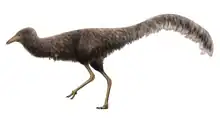

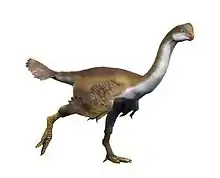
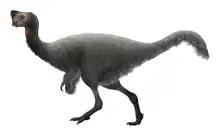
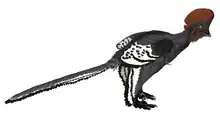


.png.webp)


.jpg.webp)
